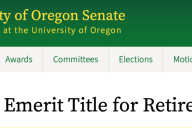You have /5 articles left.
Sign up for a free account or log in.
At 62 years old, Janice Koch decided to hang it up …. sort of. Having joined Hofstra University as an instructor in 1989, Koch chose in August to step down from her post as a professor of science education and director of an institute focused on enhancing the public’s understanding of science. But like many retiring faculty today, Koch has kept a toe dipped in the world of academe. While she has more time for family and quiet contemplation, Koch can still be spotted at National Science Foundation conferences or working on textbooks for K-12 teachers.
“I don’t feel retired in any traditional sense of the word,” says Koch, who moved to Maryland recently to be closer to family. “I feel very much engaged in professional activity. I just feel like the treadmill is slower, more manageable, yielding more time for myself, my family, personal reflection, creativity, new projects, new ideas, new horizons. It’s a very exciting time.”
When it came to retirement, Koch took some convincing, but Hofstra is among a number of universities trying to make that decision easier through attractive incentive offers. The university now encourages faculty to declare their retirement date five years in advance, and in exchange Hofstra pays out an additional 170 percent of their salary over their last five years or provides a one-course reduction in annual teaching loads.
“They take the money; probably 95 percent of them take the money,” says Herman Berliner, the university’s provost and a blogger for Inside Higher Ed.
Hofstra started its program some time ago to encourage faculty to get serious about developing retirement plans, but an increasing number of institutions have created similar incentives in recent years for the express purpose of dealing with budget shortfalls. Rather than take the controversial and complicated step of laying off tenured faculty, these universities are offering buyouts to clear faculty lines that may then be left open or filled with more junior professors who don’t command such hefty salaries.
Faced with mounting budget cuts, the University of South Florida has rolled out a retirement incentive program that is generating considerable buzz. Indeed, the limited offers of one year’s pay and accrued vacation or sick leave for faculty who have served 10 years or more created rumors that professors would be camping out in hallways to ensure they'd be among the first to submit their applications. While South Florida will still offer its packages on a first-come, first-served basis, the university has since decided to allow faculty to apply electronically – avoiding the potentially “unseemly” prospect of professors curling up in sleeping bags outside human resources offices for days on end, says Dwayne Smith, senior vice provost.
The intense interest in South Florida’s program, which appears to be a first for the university, is driven in part by the prospect that it may not be offered in subsequent years. Moreover, the university has thus far only said it will set aside $2 million for the nearly 660 eligible faculty.
“If the demand plays out larger than what we’ve anticipated and some of the rumors come true, I think we’ll be willing to dig deeper,” Smith says.
South Florida has been careful to note that it won’t guarantee future reemployment to professors who take the incentive. While there may be practical budgetary reasons for that warning, the university is also acknowledging a new Florida law designed to prevent state employees from collecting a paycheck and pension from the same agency. The practice, derided by critics as “double dipping,” has been prevalent at Florida’s universities. South Florida, which was slower to respond with disclosures about "double dipping" than other state institutions investigated by the St. Petersburg Times, endured particular criticism.
Purdue May Curtail Contributions
At a time when colleges have an interest in increasing faculty retirements, there has been considerable speculation that professors may delay retirement because of losses in their financial portfolios. As enhanced retirement incentives become more common, some faculty may also be holding out to see what universities without such plans will eventually offer them. Howard Zelaznik, chair of Purdue University’s Faculty Senate, says he’s already seen some faculty waiting to declare retirement in anticipation of greater benefits.
“I think faculty right now are postponing retirement, waiting for a better deal,” says Zelaznik, a professor in the department of health and kinesiology. “They believe the university will perhaps give them some incentive – either medical benefits for X number of years, cash payout or something to make their retirement more to their financial benefit – and (in return) the university will save either their whole salary or the differential of hiring younger faculty to (succeed) them.”
Some changes to retirement policies may be afoot already at Purdue, where officials are considering a proposal that would reduce employer contributions to retirement and steer those funds toward salary increases. Current budget projections, which would include raises and maintain current contributions, would place Purdue $67 million in the hole by 2012, officials say. By reducing expenditures and retirement contributions, however, Purdue can still provide raises and avoid going into the red, according to Al Diaz, executive vice president for business and finance and treasurer at Purdue.
“This is something that frankly we’re doing now because we don’t have any other mechanisms to provide resources for increasing salaries, and there are people that find themselves in circumstances where they need income and might be able to compromise on savings,” Diaz said.
But the proposal has met with resistance from faculty, who view Purdue’s attractive retirement plan – an average employer contribution of 14.6 percent with no employee matching required – as essential to faculty retention.
“The faculty are concerned that if we just become average in terms of retirement and average in terms of salary that we will actually be raided more than we are (already),” Zelaznik said.
In a survey conducted last May by the TIAA-CREF Institute, 4 percent of responding higher education employees said their employer’s contribution rate had changed in the preceding year. Of those who reported changes, 73 percent said there had been a decrease in contributions. The survey does not capture what has happened with plans in the last nine months, but there are anecdotal examples of contributions declining. Brandeis University announced in May that it would suspend retirement contributions, and Sweet Briar College declared the same in November.
Scant Evidence Plans Are Effective
Retirement incentive plans may be increasingly in vogue during tough budget times, but the jury is still out on whether the programs are in the long-term interests of the institutions developing them, according to Valerie Martin Conley, an associate professor of higher education and director of the Center for Higher Education at Ohio University.
“What I believe from the research I’ve done is that clearly these are still very much ad hoc programs, because we really have very little systematically collected evidence that would tell us about the effectiveness of these programs,” Conley said.
A university may call its program a “success” if the number of faculty participating in an incentive program matches predetermined goals, but that figure alone fails to capture the other variables needed to assess whether an incentive program is effective, Conley said. If a disproportionate number of participants are faculty in high-demand courses, for instance, a university may find itself scrambling to maintain class offerings.
“When the markets dip, people go back to school,” Conley said. “At a time when you’re looking to decrease your staff, you may increase enrollment. It’s a very complex equation when you think about all the different aspects you have to take into consideration.”
That complex equation is on the minds of administrators at Missouri State University, where a retirement incentive package has been designed to reduce faculty numbers in order to deal with budget reductions. While the university is offering new incentives, Missouri State will limit the number of faculty in any one program who can take advantage of it.
The university will have at least a 5.2 percent cut in the next fiscal year, and a larger deficit is expected in 2012 as federal stimulus money dries up. Missouri State expects about 40 faculty to retire under its program, and a savings of $1.8 million to $1.9 million is anticipated if those professors are re-hired at half-time or replaced by newly hired half-time faculty. Those savings will be used to help address deficits, officials say.
The Missouri State program offers the approximately 180 eligible faculty members a cash payment of 25 percent of their base annual salary or the extension of university-paid health insurance until the faculty member turns 65. To be eligible for the program, a faculty member's age and length of service must be equal to 80 or more.
Michael Nietzel, president of Missouri State, says he thought the program could free up funds to hire some fresh faculty with new ideas. On the other hand, it could also entice professors to retire who remain real assets to an economically struggling university.
“You’ve got some wonderful teachers with great institutional knowledge, and I do think there’s a cumulative loss to the institution’s culture when (they retire), particularly when it happens over consecutive years,” Nietzel says
Some retirement incentive programs, however, appear specifically designed to bring new blood into an institution. George Washington University’s School of Engineering, which has stated desires to recruit more research-oriented faculty, recently offered buyouts to 39 faculty members, six of whom accepted.
“The idea is that the university would like to encourage people who are not research-active to leave. I think that’s the bottom line,” says Murray Loew, a professor of in the department of electrical and computer engineering. “But they can’t say (that), or at least they didn’t want to try to distinguish between those who were and those who weren’t (active researchers), so they simply made a blanket offer.”
Any incentive program that appears designed to weed out particular types of faculty runs the risk of offending professors, but if Loew was perturbed he didn’t share that with Inside Higher Ed or the university’s student newspaper, which first reported on the buyouts.
“Every person is going to take it differently,” he says. “In my own case, I’m reasonably research-active and I personally feel I have things to contribute. I’m happy being here and doing what I’m doing, so as an individual I didn’t intend to take it from the start. I thought about it briefly, and then said ‘No, I want to stay here.’ ”
For others, however, incentives are just enough to justify stepping down. Jerome Delamater, a Hofstra professor of film studies, was enticed by the university’s incentives in 2006, and left after 28 years at the age of 63.
Having taken a hit on his investments in the last year, Delamater now says he’s unsure whether he would still make the same decision today. Even so, the former faculty member has found much to enjoy in life after academe.
“Part of (what motivated) my decision was ‘My God, there are so many things I want to do that I never have time to do,' ” he says. “I have read so many more things related and things unrelated to the field (I taught in) than I ever had time to do. It’s much more academically exciting to read professional work than student papers, for heaven’s sake.”








